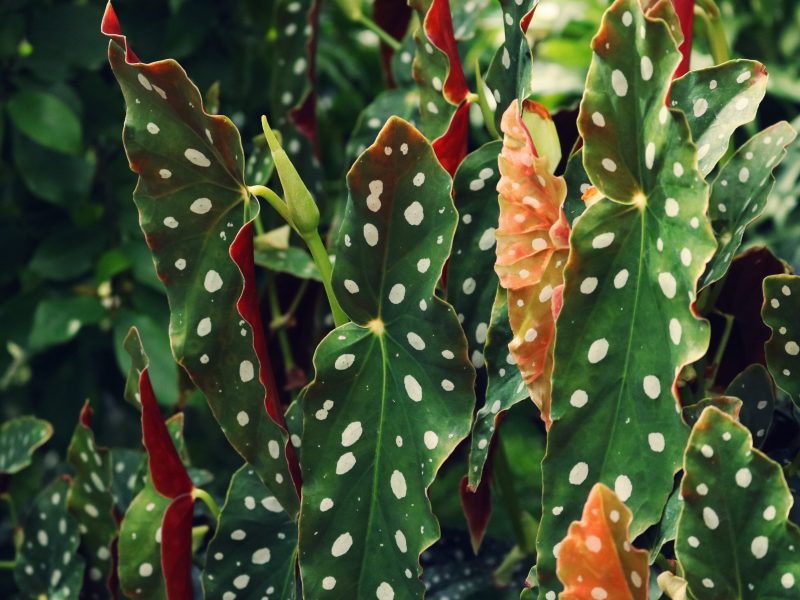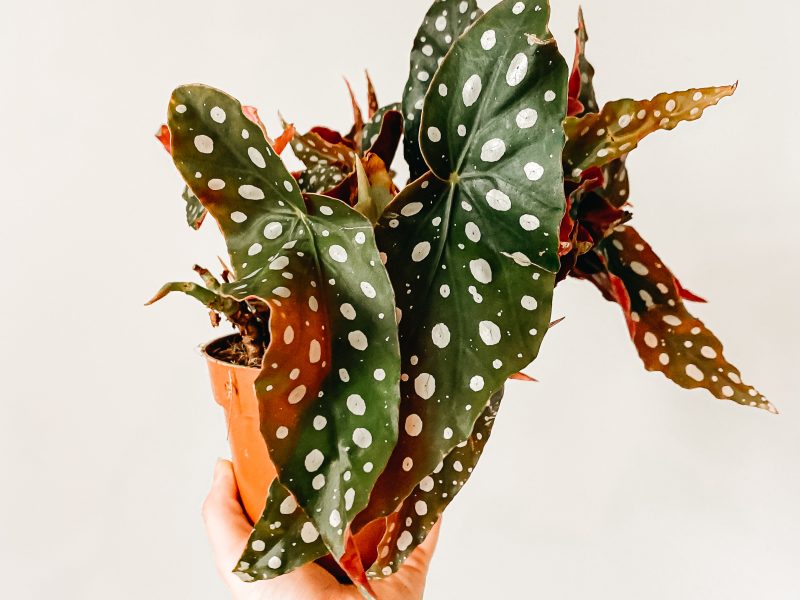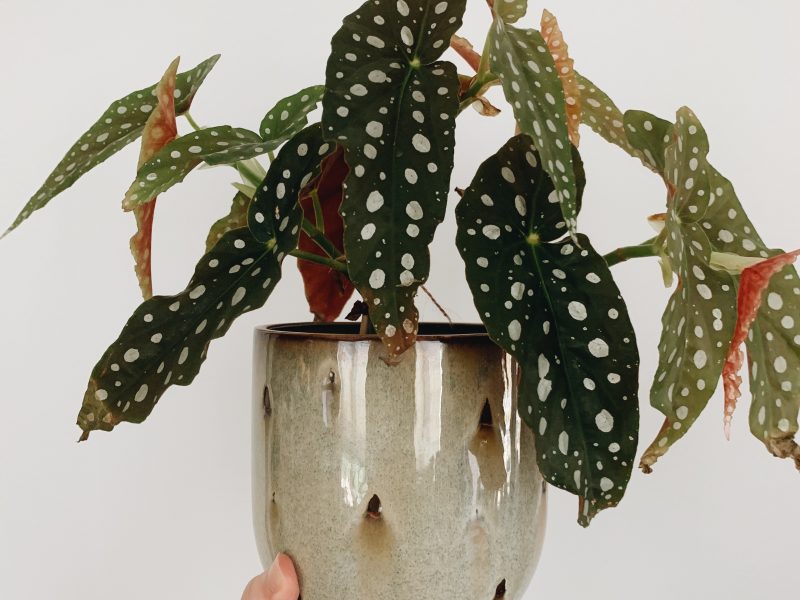Polka dot begonia leaves

Native to the rainforests of Brazil, the Polka Dot Begonia is actually a fairly low-maintenance plant despite its delicate leaves. They look like they would be quite fussy and sensitive but they can actually adapt to quite a wide range of environments.
It’s clear to see how the Polka Dot Begonia got its name as it has beautiful dotted dark green leaves with deep red undersides. It can also go by the name Spotted Begonia, Clown Begonia and its Latin name Begonia Maculata.
Below you will find our complete Polka Dot Begonia care guide with all the info you need to keep your plant thriving.
How to Care for a Polka Dot Begonia
There are three main things to consider when caring for your Polka Dot Begonia and they are sunlight level, your watering routine and pruning.
Spotted Begonias love sunshine but it needs to be indirect. They have very thin, delicate leaves which are easily scorched by intense sunlight. You want to find a spot with medium to bright, indirect light for your plant to really thrive. It can survive in lower light levels but you may see some issues and slower growth as a result.
Getting the right watering balance is the most difficult thing about caring for these plants as they hate their soil becoming too dry but also can suffer quickly in waterlogged soil. Monitor the soil moisture to ensure you are leaving just enough time between waterings and remember to adjust your routine to align with changes in the environment such as seasonal light changes.
The third pillar of Polka Dot Begonia care is pruning. Without regular pruning, they can become quite leggy and straggly. However, pruning in the right way can promote much bushier growth.
Polka Dot Begonia Overview
Origin: Rainforests of Brazil
Latin Name: Begonia Maculata
Common Name(s): Polka Dot Begonia, Spotted Begonia, Clown Begonia
Plant Family: Begoniaceae
Difficulty Level: Moderate
Appearance: Long dark green leaves with white or silver dots throughout. Their undersides are also very strikingly orangey/red
Height and Size: 24 inches (60 centimeters) in height
Growth Rate: Moderate
Flowering: Small white and pale pink flowers
Pruning: Regular pruning is required to promote bushy growth
Cleaning: Dust regularly to prevent build-up
Light Requirements: Bright, indirect light is ideal but can adapt to lower light areas. Avoid all direct sunlight.
Water Requirements: Moderate. Potting mix should be moist but not soggy and shouldn’t fully dry out.
Best Soil: Well-draining potting mix
Ideal temperature: 65-85°F (18-29°C)
Fertilizing Routine: Apply a well-balanced 10-10-10 fertilizer at half the recommended strength once a month during the growth period.
Ideal Humidity Level: 45-55% humidity
Propagation: Through stem cuttings
Repotting Frequency: Every 1-2 years
Toxicity: Toxic to pets and humans when ingested
Risk of Pests: mealybugs, aphids, scale insects and thrips
Common Problems: Dropping leaves, brown leaves, curling leaves
Spotted Begonia Origin and Rarity
Native to the rainforests of Brazil, the Begonia Maculata was first discovered in the early 1980s. Now it has become one of the most popular houseplants and is quite easily available in plant shops and nurseries across the world.
Spotted Begonia Family
The Begonia Maculata is part of the Begoniaceae family which consists of over 2,000 species of flowering perennials.
Polka Dot Begonia Appearance
The Polka Dot Begonia has very distinctive dark green elongated leaves adorned with white or silver spots throughout. They also have red leaf undersides which are striking and memorable!
Polka Dot Begonia Height and Size
They are fairly compact plants and will grow to a maturity of 24 inches (60 centimeters) in height and spread.
Polka Dot Begonia Growth Rate
If in the right environment and given the right care, Spotted Begonia plants can be fairly fast-growing. However, they tend to naturally become quite leggy when not pruned, so regular cutting back of your plant is required to shape it well.
Flowers on a Polka Dot Begonia
During spring and summer, mature Spotted Begonia plants can grow a cluster of small white or pale pink flowers. The flowers won’t often last long but they are pretty!
Pruning your Polka Dot Begonia
Pruning is a necessary step in caring for your Polka Dot Begonia and keeping it bushy and healthy. Over time, Clown Begonia will naturally become quite leggy and straggly and need to be pruned. Whenever you make a cut, two stems and leaves will form from that cut which is how you are able to shape your plant.
Aside from pruning to create bushier growth, it’s also important to prune any growth that has started to wilt and die. If your Spotted Begonia has developed any brown or yellow leaves, it’s best to remove any that are mostly discoloured as the damage is irreversible.
Make sure to use sharp shears when cutting back growth to avoid rough cuts which can harm potential new growth.
Cleaning a Polka Dot Begonia
Cleaning the leaves regularly is important to prevent a large build-up of dust on your plant. Not only can a layer of dust form a barrier between the sunlight and your plant, but it can also clog up the tiny pores in the leaves.
Use a damp cloth to clean your plant, making sure to place your hand at the back of each leaf as support. As they are very delicate, cleaning them rigorously can cause damage so do be careful.
If the leaves are particularly dirty or sticky, use a drop of two of dish soap but stay away from any harsh chemicals. They can damage the surface of the leaf and cause discolouration.
Spotted Begonia

Polka Dot Begonia Light Requirements
Polka Dot Begonia plants thrive in bright but indirect sunshine. Avoid exposing them to direct sunlight as this can really damage the leaves and permanently scorch them. A great way to make sure your plant is getting the right amount of light is by picking up a light meter. They are super affordable and available on Amazon here.
When it comes to lower light levels, your Polka Dot Begonia will happily adapt to medium light but can struggle in very low light. You may see issues develop such as brown leaves, your Begonia dropping leaves or new growth being slow and small.
Water Requirements for a Polka Dot Begonia
You want to be watering your Polka Dot Begonia once a week during the growing months to ensure the soil is moist but not soggy. Make sure the soil is dry before you water as too much moisture can cause root rot.
We always prefer to use a moisture meter to determine if your plant needs watering as root rot is something you really want to avoid.
Another way you can help avoid root rot is to use terracotta pots. Plastic pots hold in every drop of moisture, whereas terracotta or clay pots allow some of the water to evaporate through the sides. We love these ones from Amazon.
It’s important that you adjust your watering routine throughout the seasons so that you aren’t watering as deeply in winter. The cold temperatures will mean the soil takes longer to dry out so cut back on how much you water and then increase again as the temperature rises in spring.
Best Soil for a Polka Dot Begonia
Choose a high-quality well-draining potting mix for your Polka Dot Begonia. Perlite is the most important ingredient to look out for as that helps with aeration and drainage. Most well-draining potting mixes will already contain perlite but you can also buy it individually and add it into any soil.
Polka Dot Begonia Temperature Requirements
One great thing about Polka Dot Begonia plants is that they will happily thrive in the natural temperature of your home.
You do want to keep your plant away from any temperature extremes though so look out for things that can cause cold drafts and hotspots. A lot of common issues (such as leaves falling off, drooping and turning brown) are caused by cold drafts from windows, external doors and air conditioning units.
You also need to be cautious of hotspots that can form around windows in summer as well as cookers, radiators and heating vents. It’s a problem for most houseplants but is especially problematic for the Spotted Begonia because they have such thin leaves. They can easily dry out in hot air, turning brown and crispy.
Monitoring temperature is super easy with a digital thermometer and it will allow you to make any needed changes before it’s started to impact your plant’s health.
Spotted Begonia Fertilizer Requirements
Apply a well-balanced 10-10-10 fertilizer once a month during spring and summer to feed your Polka Dot Begonia. This can encourage both new healthy leaves but also blooming and flowering in the growth period.
We really love this liquid fertiliser from Miracle Gro. Choosing a water-soluble fertilizer makes it really easy to adjust the strength and frequency to fit your plant’s needs. We always recommend fertilizing at less than the recommended dosage as it’s impossible for all plants to need the same amount.
There are so many factors such as plant age, size, and temperature that impact fertilization needs so it’s better to be cautious and fertilize less than suggested. Fertilizing too much can cause a range of issues, stagnant growth ironically being one of them but the first issue you’ll see is yellow leaves across your plant.
Ideal Humidity Level for your Polka Dot Begonia
The ideal humidity range for a Polka Dot Begonia is between 45-55% humidity. They don’t like the air to be super dry as this can slowly dry out the leaves, starting with brown spots/tips and developing into patches and entire dry leaves.
Boosting the humidity can be easy though as you can choose between a variety of cheap and easy methods. Misting gently is a great habit to get into and building a pebble tray can have great results. We also recommend buying a humidifier to give a nice steady boost.
You can visit our houseplant humidity guide to find out more.
Polka Dot Begonia

Propagating your Polka Dot Begonia
Propagate from a stem cutting (making sure there is a stem node attached). Place the cutting in water and after a few weeks, roots should begin to show meaning you can repot your cutting into fresh soil.
We’ve written a detailed guide on how to propagate a Polka Dot Begonia which we recommend reading before taking it on!
Repotting your Polka Dot Begonia
You should be on average repotting your Polka Dot Begonia every 1-2 years. If not repotted frequently enough, your Philodendron Birkin will start to stunt its growth as there is nowhere else for the root system to expand to sustain larger growth.
There are several signs of a rootbound Spotted Begonia to look out for to suggest it needs to be repotted. Firstly, if you see the roots growing out of the drainage holes, or out of the top of the pot. Another sign is if the roots are tightly coiled and there isn’t much potting soil left (the only way to see this one is by removing it from its pot).
When the time comes to repot your plant you need to be sure that you don’t use a pot that is too big as this can not only cause the plant to become unstable but it can also increase the time needed for the soil to dry out which increases the risk of root rot.
Polka Dot Begonia Toxicity to Humans and Pets
Begonia Maculata are toxic to pets and humans when ingested. Although it won’t cause serious long-term damage, ingestion can cause mouth, tongue, throat and stomach irritation. It can in some cases cause vomiting and diarrhoea when ingested in large amounts.
The taste of the plant is actually quite sour so it should put your pet off nibbling at the leaves but it’s still worth putting this one a little more out of reach of your pets as it is toxic.
Treating and Preventing a Pest Infestation
Although rare, your Spotted Begonia can suffer from a range of pests including mealybugs, scale insects, aphids and thrips.
Make sure to give your Begonia (and all other houseplants) a thorough check-up once a month as treating a pest infestation early is the key to successfully getting rid of it. Checking over the leaves will also help you spot other common problems early.
If you do spot pests (or signs of them which include small yellow or brown spots, holes in the leaves and white powder on the stems) on your Polka Dot Begonia, isolate it from all other plants before starting treatment. Then remove the worst affected leaves, wash them down in the shower and treat it with neem oil and an insecticide.
Polka Dot Begonia Common Problems (and Solutions)
Why are my Polka Dot Begonia's leaves drooping?
If you notice that the leaves and stems on your Polka Dot Begonia are drooping down, this is an indication that your plant needs more water.
Check the moisture in the soil and adjust your watering schedule accordingly. The most reliable way to check the moisture levels in the soil is by using a moisture meter.
Why is there white mildew on my Spotted Begonia?
This is called powdery mildew and can be a result of misting the leaves of your Polka Dot Begonia too much. You want to ensure that there is no moisture on your plant’s leaves (especially overnight) as this is what is causing a build-up of mildew.
Why does my Polka Dot Begonia have yellow leaves?
Yellow leaves on a Begonia Maculata indicate your plant has received too much water. Replace the soil if it is waterlogged with fresh houseplant mix and hold off watering as much as you were before. To prevent more yellow leaves from developing in future, it’s important to allow the potting mix to dry out between waterings.
You also want to make sure that there is good drainage in the pot, so check your pot has drainage holes as otherwise all that moisture is being retained which can lead to yellow leaves. You can also add perlite to the potting mix to aid drainage and aeration.
It’s also important to know that some yellowing on Spotted Begonia plants is totally normal. If one or two of the oldest leaves turn yellow each year then this is just natural ageing.
Why are there brown edges on my Polka Dot Begonia's leaves?
Brown edges on a Polka Dot Begonia’s leaves indicate too much sunlight. Make sure your Polka Dot plant is away from direct sunlight as this can very easily scorch and burn the leaves. Pick up a light meter if you aren’t sure exactly where to place your plant – we love them as they help you monitor the light levels across the day.
Why is my Polka Dot Begonia losing/dropping leaves?
If you notice quite a few leaves dropping from your Polka Dot Begonia this indicates too much water or temperature shock. Check the moisture in the soil and move your plant away from any drafty doors or windows as this may be why leaves are falling off.
Using moisture meters and digital thermometers can help you assess your care and environment to make sure it’s right for your Polka Dot Begonia. Catching issues early can really help prevent your Polka Dot Begonia from losing leaves in future.
Why does my Polka Dot Begonia have brown leaf tips?
Brown leaf tips on a Polka Dot Begonia are often caused by underwatering. Try increasing the frequency of watering a little but keep an eye on the soil moisture to avoid any root rot occurring.
Why does my Polka Dot Begonia have brown leaves?
If the entire leaf is turning brown, rather than the tips or edges, then this suggests you are overwatering your Spotted Begonia. Often the leaves will turn quite dark brown in colour, become quite soft and droopy and can even fall off your plant.
Carefully take your Clown Begonia out of its pot and replace the soil if waterlogged. You don’t want to wait for the potting mix to dry out naturally as this risks more leaves turning brown.
Why are the leaves on my Polka Dot Begonia curling?
The leaves on a Begonia Maculata can begin to curl for a variety of reasons, most commonly temperature extremes. These plants don’t do so well with both hot and cold air so we recommend buying a digital thermometer to keep track of any fluctuations that might be causing the leaves on your plant to curl.
Other causes of curling leaves include underwatering (they’ll also look and feel quite crispy), overfertilization and too much direct sunshine.














